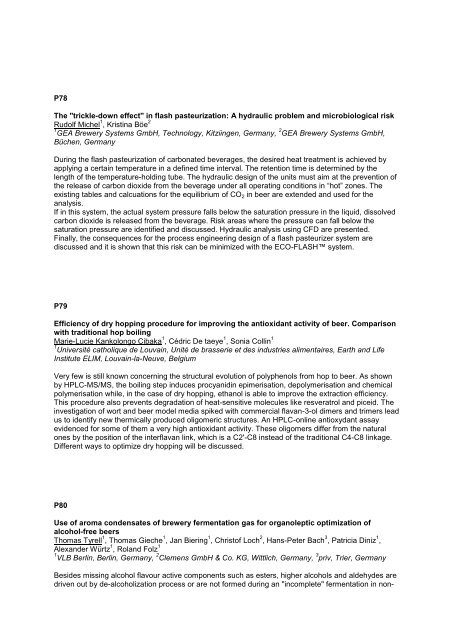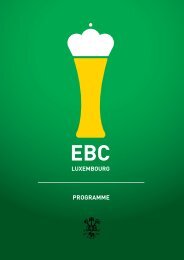here - the 34th European Brewery Convention
here - the 34th European Brewery Convention
here - the 34th European Brewery Convention
Create successful ePaper yourself
Turn your PDF publications into a flip-book with our unique Google optimized e-Paper software.
P78<br />
The "trickle-down effect" in flash pasteurization: A hydraulic problem and microbiological risk<br />
Rudolf Michel 1 , Kristina Böe 2<br />
1 GEA <strong>Brewery</strong> Systems GmbH, Technology, Kitziingen, Germany, 2 GEA <strong>Brewery</strong> Systems GmbH,<br />
Büchen, Germany<br />
During <strong>the</strong> flash pasteurization of carbonated beverages, <strong>the</strong> desired heat treatment is achieved by<br />
applying a certain temperature in a defined time interval. The retention time is determined by <strong>the</strong><br />
length of <strong>the</strong> temperature-holding tube. The hydraulic design of <strong>the</strong> units must aim at <strong>the</strong> prevention of<br />
<strong>the</strong> release of carbon dioxide from <strong>the</strong> beverage under all operating conditions in “hot” zones. The<br />
existing tables and calcuations for <strong>the</strong> equilibrium of CO 2 in beer are extended and used for <strong>the</strong><br />
analysis.<br />
If in this system, <strong>the</strong> actual system pressure falls below <strong>the</strong> saturation pressure in <strong>the</strong> liquid, dissolved<br />
carbon dioxide is released from <strong>the</strong> beverage. Risk areas w<strong>here</strong> <strong>the</strong> pressure can fall below <strong>the</strong><br />
saturation pressure are identified and discussed. Hydraulic analysis using CFD are presented.<br />
Finally, <strong>the</strong> consequences for <strong>the</strong> process engineering design of a flash pasteurizer system are<br />
discussed and it is shown that this risk can be minimized with <strong>the</strong> ECO-FLASH system.<br />
P79<br />
Efficiency of dry hopping procedure for improving <strong>the</strong> antioxidant activity of beer. Comparison<br />
with traditional hop boiling<br />
Marie-Lucie Kankolongo Cibaka 1 , Cédric De taeye 1 , Sonia Collin 1<br />
1 Université catholique de Louvain, Unité de brasserie et des industries alimentaires, Earth and Life<br />
Institute ELIM, Louvain-la-Neuve, Belgium<br />
Very few is still known concerning <strong>the</strong> structural evolution of polyphenols from hop to beer. As shown<br />
by HPLC-MS/MS, <strong>the</strong> boiling step induces procyanidin epimerisation, depolymerisation and chemical<br />
polymerisation while, in <strong>the</strong> case of dry hopping, ethanol is able to improve <strong>the</strong> extraction efficiency.<br />
This procedure also prevents degradation of heat-sensitive molecules like resveratrol and piceid. The<br />
investigation of wort and beer model media spiked with commercial flavan-3-ol dimers and trimers lead<br />
us to identify new <strong>the</strong>rmically produced oligomeric structures. An HPLC-online antioxydant assay<br />
evidenced for some of <strong>the</strong>m a very high antioxidant activity. These oligomers differ from <strong>the</strong> natural<br />
ones by <strong>the</strong> position of <strong>the</strong> interflavan link, which is a C2'-C8 instead of <strong>the</strong> traditional C4-C8 linkage.<br />
Different ways to optimize dry hopping will be discussed.<br />
P80<br />
Use of aroma condensates of brewery fermentation gas for organoleptic optimization of<br />
alcohol-free beers<br />
Thomas Tyrell 1 , Thomas Gieche 1 , Jan Biering 1 , Christof Loch 2 , Hans-Peter Bach 3 , Patricia Diniz 1 ,<br />
Alexander Würtz 1 , Roland Folz 1<br />
1 VLB Berlin, Berlin, Germany, 2 Clemens GmbH & Co. KG, Wittlich, Germany, 3 priv, Trier, Germany<br />
Besides missing alcohol flavour active components such as esters, higher alcohols and aldehydes are<br />
driven out by de-alcoholization process or are not formed during an "incomplete" fermentation in non-





